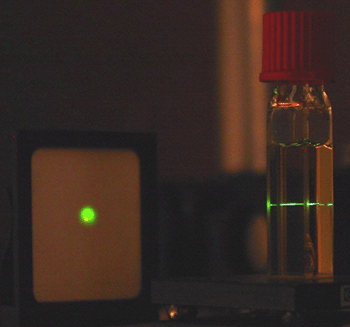A highly efficient laser based on ‘three-photon excitation’ has been demonstrated by Guang He and colleagues at the State University of New York at Buffalo. The device emits visible light when it is excited by infrared radiation of the frequency used in optical communications. Besides improvements in fibre optics technology, the effect could lead to new techniques for data storage and medical imaging (G He et al 2002 Nature 415 767).

In a conventional ‘optically pumped’ laser, the atoms or molecules in an optically active material are excited to higher energy levels by single photons from another laser. When the atoms or molecules fall to a lower energy level, they emit light with a well-defined wavelength. Mirrors reflect this light back and forth through the material stimulating further emission, which leads to an intense beam of coherent light.
He and colleagues have now shown that the molecules in a laser material can be excited by absorbing three photons at once. Such ‘multiphoton absorption’ was first predicted in 1931, and two-photon absorption is already used in many applications.
Processes based on two-photon absorption are efficient because the level of excitation of the medium is related to the square of the ‘pump’ light intensity. This relationship becomes cubic if three photons are absorbed, leading to even greater efficiency. A laser based on three-photon absorption can emit extremely intense light from a very small area, and can be excited by lower-energy photons – that is, longer-wavelength radiation.
He and co-workers used pulses from a ‘pump’ laser with a wavelength of 1.3 micrometres – the main wavelength used in optical communications – to stimulate an optically active organic solution. This solution then emitted yellowy-green light with a wavelength of 550 nanometres. This frequency-shifting effect – known as up-conversion – arises because three-photon absorption is so efficient.
According to the team, this effect could have many uses in fibre-optic communications systems, including frequency shifting. “Shorter wavelengths are also desirable for data transmission because they allow for higher density data storage and higher resolution of that data”, says He.
The sensitivity of the organic solution to infrared radiation – which travels further though human tissue than visible light – could also lead to new medical imaging techniques that are less harmful than X-rays.


